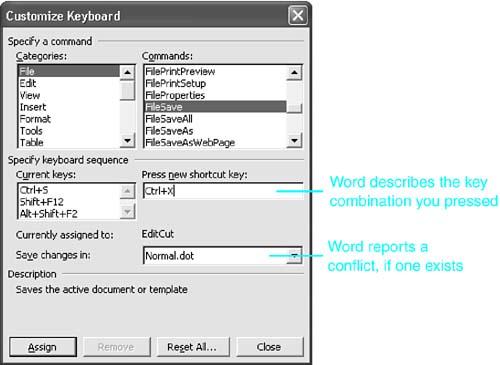Creating New Keyboard Shortcuts
You probably know that Word contains hundreds of keyboard shortcuts: Ctrl+F for Find, Alt+Shift+X to insert an index entry, and so on. If you want, you can change those keyboard shortcuts or add new ones. When might you want to?
When you're switching from another word processor whose keyboard shortcuts you're accustomed to
When you find yourself often using a command or macro that doesn't come with a keyboard shortcut
Associating Keyboard Shortcuts with Commands, Symbols, Fonts, Macros, and Other Elements
Many existing toolbar buttons and menu items already have keyboard shortcuts. Others that you use quite often may not. Or, perhaps, you're comfortable with toolbar buttons, menus, and keyboard shortcuts that Word provides, but you'd like more of them.
For example, how about adding a keyboard shortcut to apply a specific font or style you work with regularly? Or to insert a specific AutoText entry? Or to add a specific foreign-language accent mark or symbol you use every day? Or perhaps you recorded a macro that you didn't expect to use much, so you didn't bother to create a keyboard shortcut for it at the time. Now that you realize how useful your macro is, perhaps you want an easier way to access it.


To create a keyboard shortcut for elements such as these, follow these steps:
Choose Tools, Customize, and display the Commands tab. Pick the template or document where you want the keyboard assignment to appear by selecting it from the Save In drop-down list. (Note that keyboard assignments saved in Normal.dot are available all the time.)
Choose Keyboard. The Customize Keyboard dialog box appears (see Figure 31.15).
Figure 31.15. In the Customize Keyboard dialog box, press a keyboard shortcut to associate it with the command you've chosen.

In the Categories scroll box, choose the category containing the command you want.
In the Commands scroll box, choose the command you want.
Press the keyboard shortcut you want to set as your shortcut. The combination appears in the Press New Shortcut Key text box.
The dialog box will change to display a Currently Assigned To area under the Current Keys scroll box. If the key combination is already in use, this area tells you which function it performs. If the key combination is not in use, the word [unassigned] appears.
If the key combination you pressed was already in use, and you don't want to overwrite it, press Backspace and try another key combination. If you do want to overwrite it?in other words, if you want to change what that keyboard shortcut does?move on to the next step.
CAUTION
Word does not display any confirmation dialog box if you ask it to overwrite an existing keyboard shortcut.
If you inadvertently overwrite a keyboard shortcut you intended to keep, you can reassign it manually, using the procedure described previously. Or you can restore an individual toolbar or menu bar to its original state, by choosing it in the Toolbars tab of the Customize dialog box, and clicking Reset.
After you have a shortcut key that fits your needs, click Assign. You'll see the new key combination in the Current Keys scroll box. Click Close.
Resetting Keyboard Shortcuts
If you decide you no longer want one specific custom keyboard shortcut, display the Customize Keyboard dialog box using the Keyboard button on the Customize dialog box, select the command, and click Remove.
If you want to eliminate all custom keyboard shortcuts in the Normal template, display the Customize Keyboard dialog box and click Reset All. Because there is significant potential to wipe out a lot of work, Word asks you to confirm this action; click Yes.
CAUTION
Reset All eliminates all custom keyboard shortcuts stored in the Normal template, including keyboard shortcuts you may have created when recording custom macros.
Before you reset your keyboard settings, you may want to review them. If you want a simple list of custom keyboard assignments, click File, Print, and in the Print What drop-down box, choose Key Assignments.
For a more comprehensive understanding of your current keyboard settings, Word can generate a document containing either your current menu and keyboard settings or all Word commands using one of its built-in macros. To create such a document, follow these steps:
Choose Tools, Macro, Macros.
In the Macro Name text box, type listcommands and click Run.
The List Commands dialog box opens (see Figure 31.16). Choose to list either Current Menu and Keyboard Settings or All Word Commands.
Figure 31.16. The List Commands dialog box.

Click OK.







